Marriage Statistics
There were 26,415 marriages registered in 2017, a decrease of 3.2 percent from theprevious year’s figure of 27,298 marriages.
Two provinces recorded an increase in the number of registered marriages from 2016 to 2017. A bigger increase was noted in Ilocos Sur from 3,638 to 3,702 marriages (1.7 percent), while that of Ilocos Norte increased from 3,139 to 3,164 marriages (0.8 percent).
On the other hand, the provinces that posted a decrease in the number of registered marriages were Pangasinan from 16,473 to 15,568 (5.5 percent) and La Union from 4,048 to 3,981 (1.7 percent).
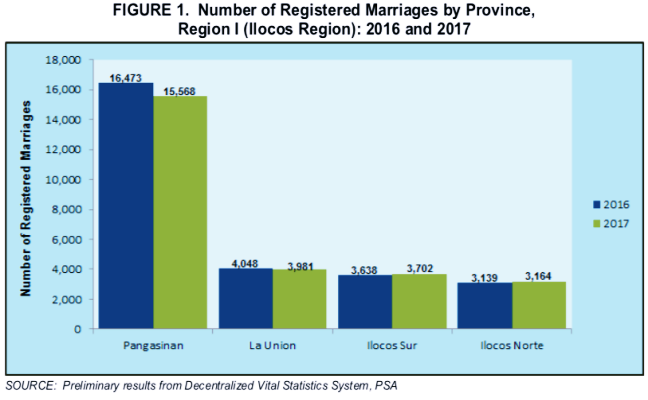
The number of registered marriages in the province of Pangasinan went down to 15,568 in 2017 from 16,473 in 2016. The province of Pangasinan had with the most number of registered marriages in the region. La Union ranked second with 3,981 (15.1 percent) followed by Ilocos Sur with 3,702 (14.0 percent). A year ago, La Union also ranked second with 4,048 marriages (14.8 percent) while Ilocos Sur ranked third with 3,638 marriages (13.3 percent).

On the other end, the province of Ilocos Norte posted the least number of registered marriages in 2016 and 2017 with 3,139 (11.5 percent) and 3,164 (12.0 percent), respectively.
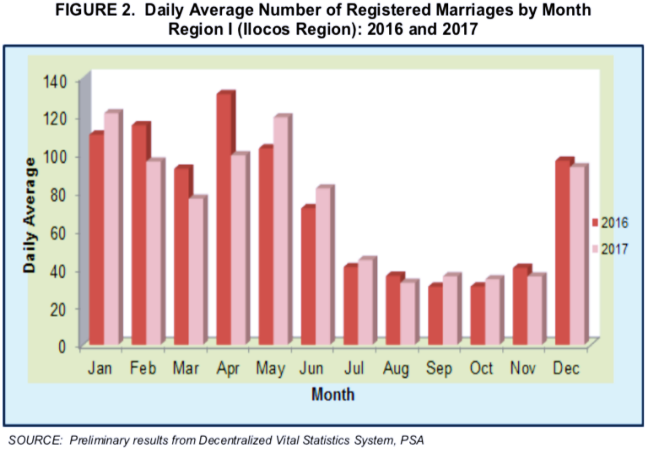
The month of January was the most preferred month to tie the knot in 2017 with a daily average of 121 marriages. The month of May ranked second with daily average of 119 marriages, followed by the months of April with 99 and February with 96 daily average of marriage occurrences.
The least number of marriage occurrences in 2017 was the month of August posting a daily average of 33 marriages. It was followed by the month of October with 34 marriages and November which recorded a daily average of 36 marriages.
On the other hand, the favorite month of couples to tie the knot in 2016 was the month of April with a daily average of 131 marriage occurrences. The months of February with a daily average of 115 and January with a daily average of 110 ranked second and third, respectively. The least favored months for marriage were the months of October and September with a daily average of 31 marriage occurrences.
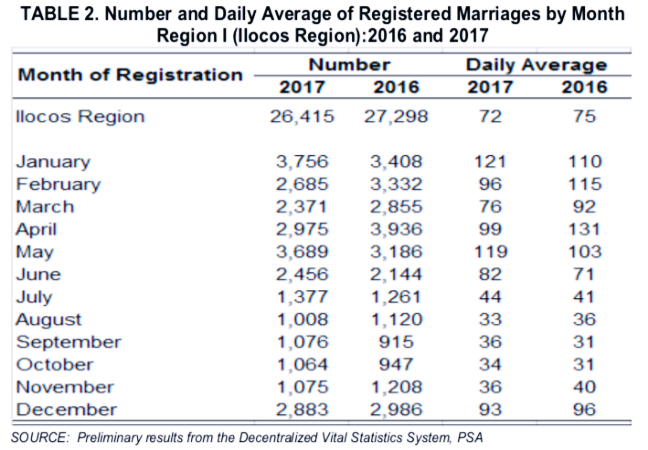
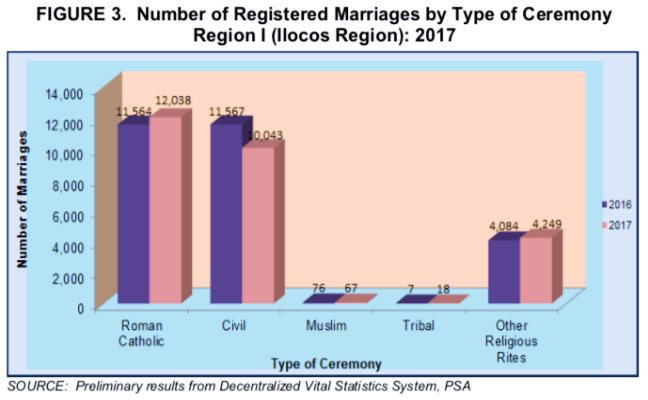
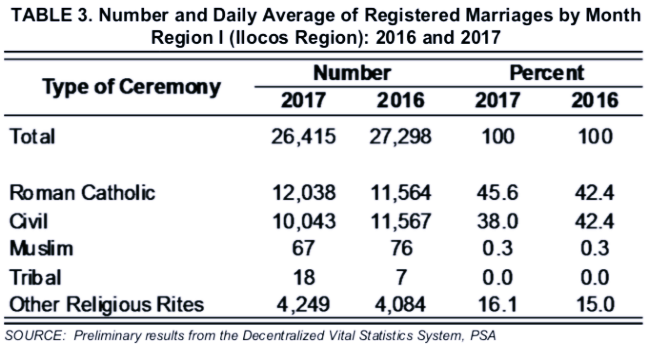
Marriages officiated in Roman Catholic Church topped the list among all types of marriage ceremonies in 2017. It comprised 12,038 marriages or 45.6 percent of the total reported marriages. Marriages performed in civil rites ranked second with 10,043 marriages or 38.0 percent share followed by other religious rites with 4,249 or 16.1 percent.
A year earlier, marriages contracted through civil rites registered the highest number of marriages with 11,567 marriages or 42.4 percent share, followed closely by Roman Catholic with 11,564 marriages or 42.4 percent share.
On the other end, marriages carried out under tribal rites posted the lowest number of registered marriages both in year 2016 and 2017 with 7 and 18 marriages, respectively.
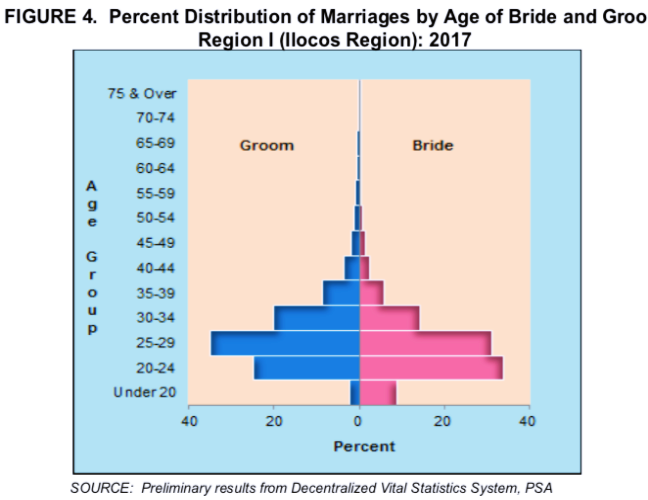
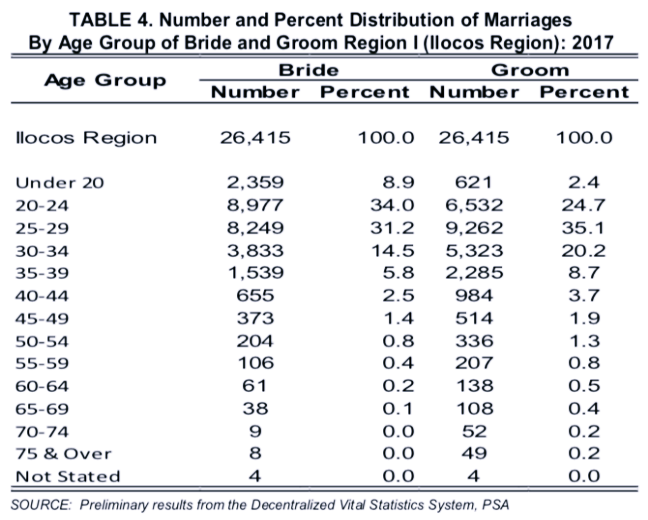
The median age at marriage for brides and grooms were 26 and 28, respectively. The largest number of brides in 2017 got married at ages 20 to 24 years (8,977 or 34.0 percent), while the largest number of grooms belonged to ages 25 to 29 years (9,262 or 35.1 percent). Moreover, the number of teenage brides (2,359 or 8.2 percent) was almost four times more than the number of teenage grooms (621 or 2.4 percent).
On the contrary, at age 50 years old and over, the number of grooms (890 or 3.4 percent) was more than twice the number of brides (426 or 1.6 percent). It can be noted that men tend to marry even on or after their golden years. Grooms aged 75 years and over (49) were six times more than the number of brides (8).
Explanatory Notes
Data on marriages presented in this release were obtained from the Certificates of Marriage (Municipal Form No. 97) that were registered at the Office of the City/Municipal Civil Registrars and forwarded to the Philippine Statistics Authority - Provincial Statistical Offices in Region I. Information included marriages registered in January to December 2017 and January to December 2016.



